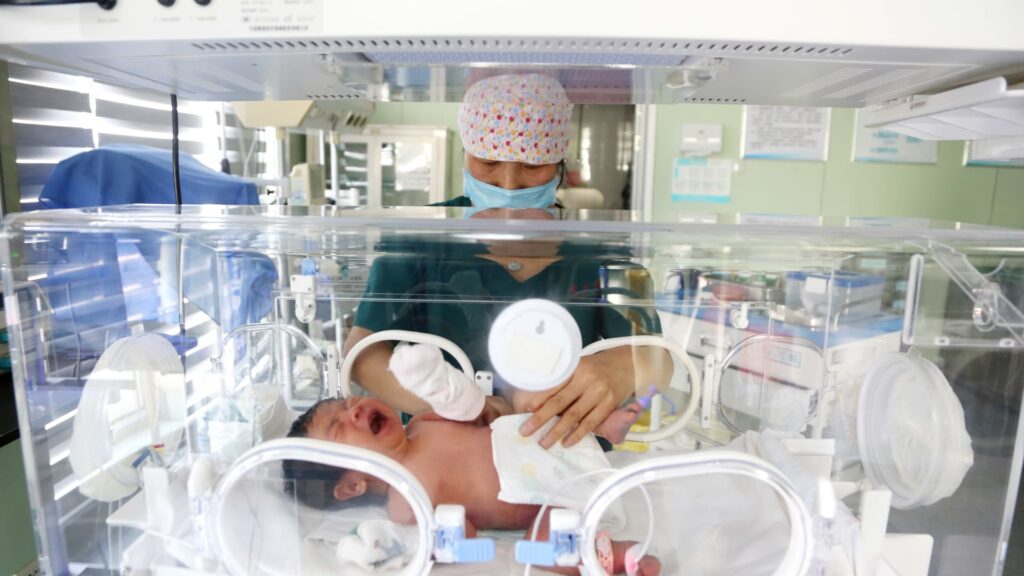A medical worker is taking care of newborns at Dongfang Hospital in Lianyungang, China, on January 1, 2024.
Costfoto | Nurphoto | Getty Images
China’s efforts to bolster birth rates have yet to address the core reasons for their rapid decline, according to analysts.
Even though the country started easing its stringent one-child policy nearly a decade ago, the birth rate has continued to plummet, with a record low of 9.02 million newborns last year.
The number of new marriage registrations also plunged by 25% year on year in the third quarter, indicating the total for the year will drop to 6.4 million, the lowest since 1979, according to financial services firm Nomura’s analysis of official data released this month.
Rather than trying to induce a sizeable “birth spurt,” China’s policies so far have been more about “supporting families [and] allowing those who do want to have a second or third child to do this with more ease and affordability,” said Lauren Johnston, associate professor of China Studies Center at the University of Sydney.
Recent measures are “a small step in a long-run agenda,” she said.
Chinese authorities last month announced high-level plans for subsidies and tax breaks to households with children under the age of 3. The measures also extended maternity leave to 158 days from 98 days. Last year, the country doubled childcare tax breaks to 2,000 yuan ($280) per month.
Births in China have been on a drastic downward trend since the government implemented its “one-child policy” nationwide in 1980. The United Nations in July forecast that China, the second most-populous country in the world, will likely lose more than half of its population by 2100 in the greatest drop of any country.
The “mental hangover” from the one-child policy has lingered and “fundamentally changed young people’s perception of families,” said Harry Murphy Cruise, economist at Moody’s Analytics. He added that slower economic growth has also led “young people to second-guess or delay plans to start a family.”
“It is an incredibly difficult task [and] there is no silver bullet to lifting fertility rates,” said Cruise.
World Bank data showed that the fertility rate, defined as births per woman, was 1.2 in China in 2022, below 1.7 in the U.S., which has benefited from a more open immigration policy.
China’s share of the world’s live births is expected to drop to around 3% in 2100 from 8% in 2021, according to Austin Schumacher, an assistant professor of health metrics sciences at the Institute for Health Metrics and Evaluation, University of Washington.
“Current studies on various pro-natal policies have only shown modest increases which our projections show will not be sufficient to reverse population decline,” Schumacher said. “However, with new innovations and research into improving current endeavors and developing new one, it could be possible.”
An increasingly pressing factor for families in China is uncertainty about income for raising a child.
After decades of rapid expansion, China’s economy has slowed down, dragged down by a real estate slump. Crackdowns on after-school tutoring, gaming, finance and internet platform companies have also hit hiring in industries that were once popular with recent graduates.
China’s youth unemployment rate — measured by those aged 16 to 24 and not in school— rose to a record high of 18.8% in August. It edged lower in September.
“The problem really is that people don’t have the confidence to make ends meet for themselves, let alone think about having enough to raise children,” said Sheana Yue, economist at Oxford Economics.
Measures that “earnestly” boost income and alleviate households’ living costs would “go a long way” in improving sentiment around childbearing in China, said Yue.
National health authorities have this year tried to encourage businesses to support maternity leave by emphasizing the availability of state funds to pay female employees who give birth.
Pressure of city life
Scholars in general have noted the link between urbanization and falling birth rates. About 83% of Americans lived in cities in 2023, versus 65% in China, according to World Bank figures. That’s up from 19% in 1980 — when the U.S. urbanization rate was 74%.
The “hectic and stressful work schedule” in big cities tends to discourage marriage and births, said Darren Tay, head of APAC country risk at BMI. That could “blunt the impact of incentives meant to encourage births.”
The share of China’s population aged 20 to 39 has already declined, indicating fewer marriages ahead, Nomura economists said.
That’s likely to lead to fewer births over the next few years, the economists said, unless there is a “material change in incentives for married couples.” They expect that at an annual parliamentary meeting in March, Beijing could announce up to 500 billion yuan ($70 billion) in annual spending to boost births.
Lack of incentives
There appears to be a lack of proper incentives aimed at boosting birth rates, while certain steps may even encroach on information many societies consider private.
For instance, a few online posts this year claimed local social workers in China indiscriminately called women asking if they were pregnant, and pressured them to pick up free folic acid.
The central government’s latest policy tasks local authorities with setting up a budget for public childcare centers and easing the limits of housing loans for families with more than one child. That leaves implementation up to local authorities, many of which have struggled financially.
Tianchen Xu, senior economist at Economic Intelligence Unit, pointed out that prior policies to encourage more births have been “inconsistent and inadequate” depending on local government finances and willingness to prioritize the measures.
To turn around the falling birth rates, China needs “a combination of strong direct financial incentives,” Xu said, particularly subsidies and benefits for housing.

